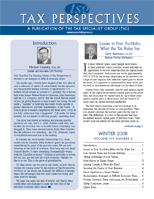
PDF Format
 Issue Contents Issue Contents
 All Issues All Issues
Winter 2008
Volume 8, Number 2
The information in Tax Perspectives is prepared for general interest only. Every effort has been made to ensure that the contents are accurate. However, professional advice should always be obtained before acting and TSG member firms cannot assume any liability for persons who act on the basis of information contained herein without professional advice.
Losses in Your Portfolio, What the Tax Rules Say
In these difficult times, many people have losses in their portfolio. Many investors would welcome an opportunity to recover some tax from the capital losses they have sustained. Such losses are worth approximately 19% to 25% in tax savings (depending on the province) for a high income taxpayer with sufficient capital gains to absorb the losses. It is important to understand how these losses may be used, so that maximum advantage can be taken of them.
Capital losses may generally only be used against capital gains. If the capital losses exceed capital gains in any given year, the losses may be carried back for up to three years against capital gains in those years, and the balance of losses may be carried forward indefinitely.
The first step in analyzing a tax loss strategy is to determine the amount of losses in your portfolio. Then you should calculate the realized gains for the year to date. The difference, if a loss, is the amount that may be applied against capital gains of previous years. Then review your tax returns for the three previous years to determine the amount of capital gains that has been realized. Note that since capital gains are 50% taxable, only 50% of the gain will be reported on your tax return.
The loss is claimed on a special form, which computes the net loss for the year, divides it by two, and designates the year to which the loss will be applied. It is generally advisable to carry back the loss to the earliest possible year, although this strategy may be varied if the tax rate in that particular year is lower than in subsequent years.
In accordance with Canadian law, capital gains and losses are to be computed in Canadian dollars. Therefore, if the shares are, for example, those of a U.S. company, purchased in U.S. dollars, the actual exchange rates at the time of purchase and at the time of sale must be used to calculate the capital gain or loss.
Because capital losses may be applied only against capital gains if the shares are considered to be capital property, some taxpayers will take the position that their stock market trading is a business and that the shares represent inventory. Accordingly, the losses will be considered to be non-capital losses and may be deducted in full against any source of income. If this position is taken, the CRA will consider it binding for future years. It is not advantageous in most cases. Furthermore, to claim that a loss is a non-capital loss, there must be extensive trading, and generally borrowings to finance the trading, to indicate a speculative activity. Persons wishing to use a tax loss realization strategy, while retaining the shares or investments should seek professional advice.
Some individuals, owning shares with significant losses, will not want to sell them, hoping that they will later appreciate in value. If such shares are sold and repurchased within 30 days, the loss will be denied. If the shares are transferred to a spouse, a spousal trust, a family trust in which the person or his or her spouse is the main beneficiary, or to a holding company controlled by such individuals, the loss may also be denied. Individuals wishing to follow a tax loss realization strategy, while retaining the investments should seek professional advice.
A question that often arises is whether a loss has actually been realized for tax purposes. For example, if shares are virtually worthless, but the company is still carrying on business, the loss will not be realized until the shares are disposed of. Even if a stock is de-listed, that does not mean a loss is realized for tax purposes. A special election can be made for worthless stock, but conditions apply. If the investment is in bonds, commercial paper, or other types of fixed income investments, a decline in value will not be sufficient to enable a loss to be realized. The debt issuer must be insolvent, which requires that the instrument is in default. The Canadian mortgage-backed commercial paper market was basically frozen in 2007. It is not clear that this action, or other subsequent events, have created an event that would cause a loss to be realized. Clearly, in some cases significant losses in value have occurred, but for tax purposes, the key event is realization of the loss, which will require a disposition.
Unfortunately, the CRA does not pay interest on the refund generated by claiming a capital loss until the related tax return is filed.
Lastly, note that foreign investments may result in gains or losses based on currency fluctuation. For a further explanation of these rules, see the article Foreign Currency Gains and Losses, the Technicalities in this issue.
|